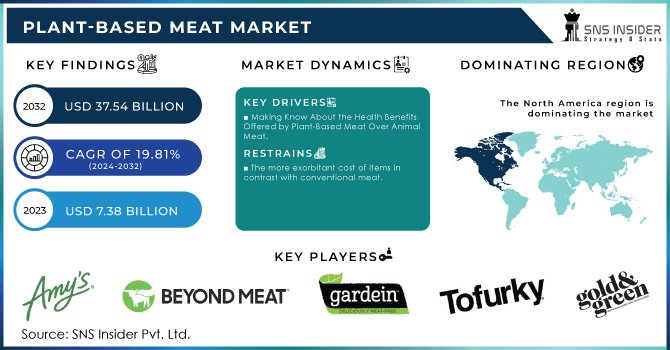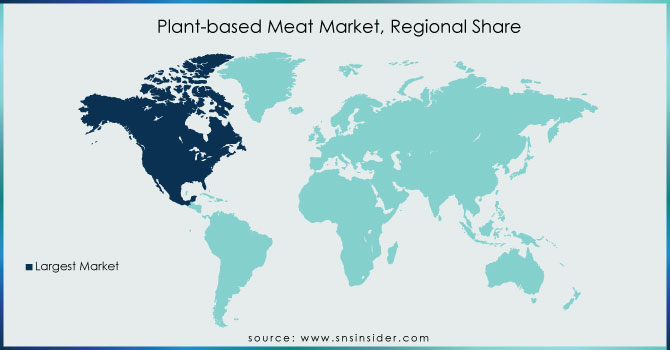Plant-based Meat Market Report Scope & Overview:
The Plant-based meat market size was valued at USD 7.38 billion by 2023 and is projected to reach to USD 37.54 billion by 2032, recording a CAGR of 19.81% from 2024-2032.
Plant-based meat is essentially meat gotten from plants. It is made to taste, look, and feel like conventional meat from creature items. Plant-based meat is healthier than customary meat as it is lower in calories and soaked fats. Coconut oil, vegetable protein concentrate, and beet juice are a portion of the fixings utilized in plant-based meat. Plant-based meat is better when consumed with some restraint as a feature of a reasonable eating routine. It likewise offers more healthful advantages than ordinary meat.

Get More Information on Plant-based Meat Market - Request Sample Report
It is seeing huge development because of developing vegetarian and flexitarian populace across the world, rising mindfulness about the medical advantages presented by plant-based meat over creature meat, and development in government drives alongside critical ventures are driving the worldwide market. The European market will rule the market, because of inventive item improvement in the area, supported with fitting innovative work offices accessible in the district.
Developing buyer premium in plant-based eats fewer carbs, combined with the rising awareness for basic entitlements through different government assistance associations is supposed to drive the market. Plant-based meat is turning into an indispensable piece of a veggie lover’s diet, wherein the people take on a vegan way of life that is absent any trace of creature-based food sources. Customers are leaning towards veganism for wellbeing and moral reasons, while different shoppers are picking veggie-lover fixings to stay away from creature savagery and to eat feasible food and drink items.
Market Dynamics:
Driving Factors:
-
Making Know About the Health Benefits Offered by Plant-Based Meat Over Animal Meat.
Restraining Factors:
-
The more exorbitant cost of items in contrast with conventional meat.
Opportunities:
-
Good advertising and the right situating of plant-based meat.
Challenges:
-
Insight in regards to the flavor of plant-based meat items.
Impact of Covid-19:
The flare-up of the COVID-19 pandemic has essentially affected the interest and development of the plant-based meat market. It is because of the disturbance in provisions of key unrefined components, limited admittance to creation spaces, and hindered dissemination channels. Foodservice channel dissemination was seriously affected, and storage space loading and frenzy purchasing were at the most elevated point across various retail deals during the underlying period of the pandemic
Besides, the burden of complete or halfway lockdown across different countries of the district has urged customers to purchase items through web-based mediums, which has additionally roused merchants to move to the web-based circulation channel. The pandemic has made more mindfulness among purchasers concerning the significance of keeping up with quality food examples and ways of life, which has additionally flooded the interest for good food substitutes including plant-based meat items.
Key Market Segmentation:
By Source:
-
Soy
-
Pea
-
Wheat
By Product:
-
Burgers
-
Sausages
-
Patties
-
Nuggets, Tenders & Cutlets
-
Grounds
By Type:
-
Chicken
-
Pork
-
Beef
-
Fish
By End-user:
-
Retail
-
HORECA (Hotel/Restaurant/Café)
By Storage:
-
Refrigerated Plant-based Meat
-
Frozen Plant-based Meat
-
Shelf-stable Plant-based Meat
The pea-based meat section is expected to observe a significant development rate during the estimated time frame. The pea-based patties could be utilized in burgers instead of hamburger, chicken, or pork-based patties. Moreover, attributes of pea-based meat like comparability in surface and consistency to meat, high protein content, simple openness, and speedy arrangement are assessed to add to the critical development of the section.
In 2020, the plant-based chicken portion secured the most noteworthy income share on the lookout. Chicken is one of the significantly involved fixings in the traditional meat industry for making a wide scope of items like patties, pieces, and cutlets since it offers protein, creature fats, and cholesterol. When contrasted with it, plant-based chicken items contain around a similar amount of protein yet different supplements can vary from one item to another.
In 2020, the burgers fragment procured the most extreme income share on the lookout. These burgers contain fixings that offer comparative flavor, fragrance, and surface to meat. A few organizations like Impossible Foods, Kraft Foods, and others are presenting various assortments of burgers containing plant-based meat.
Regional Coverage:
-
North America
-
The USA
-
Canada
-
Mexico
-
-
Europe
-
Germany
-
The UK
-
France
-
Italy
-
Spain
-
The Netherlands
-
Rest of Europe
-
-
Asia-Pacific
-
Japan
-
south Korea
-
China
-
India
-
Australia
-
Rest of Asia-Pacific
-
-
The Middle East & Africa
-
Israel
-
UAE
-
South Africa
-
Rest of Middle East & Africa
-
-
Latin America
-
Brazil
-
Argentina
-
Rest of Latin America
-
North America, driven by Canada and the U.S. plant-based meat market size is ready to enroll over10% CAGR up to 2025. European plant-based meat market interest, driven by Germany, the UK, and France is set to outperform USD 55 million by 2025. Severe guidelines on creature government assistance went with shopper attitude toward veggie lover and vegan item choices ought to encourage territorial market share. The Asia Pacific gasp-based meat industry standpoint is probably going to stay positive through 2025. APAC, driven by India, Japan, and China markets size was esteemed at over USD 30 million in 2018. Expanding heftiness and cardiovascular sickness cases in the geriatric populace are prompting consume plant-based meat items to drive industry development in the locale.

Get Customized Report as per Your Business Requirement - Request For Customized Report
Key Players:
Major players included in this report are Amy’s Kitchen, Beyond Meat, Garden Protein International, Gold & Green Foods, Greenwise, Impossible Foods, Maple Leaf Foods, Morningstar Farms, Novameat, Omnipork, Quorn Foods, Surfed, The Vegetarian Butcher, Tofurky, V2food, VBites, and Zikooin.
| Report Attributes | Details |
|---|---|
| Market Size in 2023 | US$ 7.38 Billion |
| Market Size by 2032 | US$ 37.54 Billion |
| CAGR | CAGR 19.81% From 2024 to 2032 |
| Base Year | 2023 |
| Forecast Period | 2024-2032 |
| Historical Data | 2020-2022 |
| Report Scope & Coverage | Market Size, Segments Analysis, Competitive Landscape, Regional Analysis, DROC & SWOT Analysis, Forecast Outlook |
| Key Segments | • by Source (Soy, Pea, Wheat) • by Product (Burgers, Patties, Sausages) • by Type (Chicken, Pork, Beef) • by End-user • by Storage |
| Regional Analysis/Coverage | North America (USA, Canada, Mexico), Europe (Germany, UK, France, Italy, Spain, Netherlands, Rest of Europe), Asia-Pacific (Japan, South Korea, China, India, Australia, Rest of Asia-Pacific), The Middle East & Africa (Israel, UAE, South Africa, Rest of Middle East & Africa), Latin America (Brazil, Argentina, Rest of Latin America) |
| Company Profiles | Amy’s Kitchen, Beyond Meat, Garden Protein International, Gold & Green Foods, Greenwise, Impossible Foods, Maple Leaf Foods, Morningstar Farms, Novameat, Omnipork, Quorn Foods, Surfed, The Vegetarian Butcher, Tofurky, V2food, VBites, and Zikooin. |
| Key Drivers | •Making Know About the Health Benefits Offered by Plant-Based Meat Over Animal Meat. |
| Restraints | •The more exorbitant cost of items in contrast with conventional meat. |

